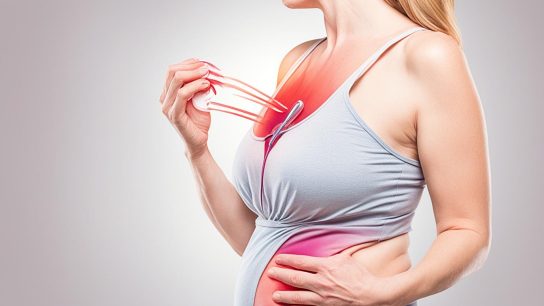As women approach the end of menopause, their bodies undergo significant changes as the hormonal balance settles into a new normal. It’s important to recognize the signs and symptoms associated with this stage of menopause to better understand and manage the process.
What Are the Signs of Coming to the End of Menopause?
Some common signs of nearing the end of menopause include:
- Mood swings and depression
- Cognitive decline
- Decreased libido
- Difficulty sleeping
- Vaginal dryness
- Weight gain or difficulty losing weight
- Hot flashes
While these signs are often experienced, it’s important to remember that every woman’s experience with menopause is unique. Some women may have more severe symptoms while others may have milder ones.
Understanding the signs of coming to the end of menopause can help women prepare and seek the necessary relief and treatment. In the following sections, we will explore the health risks associated with postmenopause, managing menopause symptoms, and understanding the stages of menopause.
Health Risks Associated with Postmenopause
Postmenopause is a phase in a woman’s life that comes with certain health risks. It is important to be aware of these risks and take proactive steps to prevent them. Some of the common health risks associated with postmenopause include:
Cardiovascular Disease
Decreased estrogen levels during postmenopause can increase the risk of developing cardiovascular diseases such as heart disease, heart attack, and signs of stroke. Lifestyle factors such as a sedentary lifestyle can further contribute to this risk.
Osteoporosis
The loss of estrogen during postmenopause leads to a decrease in bone density, putting women at a higher risk of developing osteoporosis. Osteoporosis is a condition characterized by weakened and fragile bones, increasing the risk of fractures.
Vaginal Atrophy
Vaginal atrophy is a common condition that occurs during postmenopause. It is characterized by the thinning, drying, and inflammation of the vaginal walls, leading to discomfort during intercourse. It can also cause urinary symptoms such as frequent urinary tract infections.
Mental Health Issues
Postmenopausal women may also experience mental health issues such as moodiness, anxiety, and depression. The hormonal changes that occur during this phase can impact emotional well-being and overall mental health.
To reduce the health risks associated with postmenopause, it is important to prioritize self-care and adopt a healthy lifestyle. This includes:
- Maintaining a balanced diet rich in nutrients to support overall health and bone density.
- Engaging in regular exercise, including weight-bearing exercises that help maintain bone strength.
- Seeking medical treatment for any symptoms or conditions that arise during postmenopause.
- Practicing stress management techniques and seeking support from healthcare professionals or support groups.
By taking these preventive measures, women can minimize the potential health risks and maintain their well-being during the postmenopausal phase.

Managing Menopause Symptoms
Menopause symptoms can vary widely from woman to woman, and managing these symptoms is crucial for maintaining overall well-being during this transitional phase. There are several treatment options and lifestyle changes that can help alleviate menopause symptoms and improve quality of life.
1. Hormone Replacement Therapy (HRT)
Hormone replacement therapy (HRT) is a commonly recommended treatment option for managing menopause symptoms. HRT involves taking estrogen and/or progesterone to supplement the body’s declining hormone levels. This can help alleviate symptoms such as hot flashes, night sweats, and vaginal dryness. However, it’s important to discuss the benefits and potential risks of HRT with a healthcare provider, as it may not be suitable for everyone.
2. Lifestyle Changes
Implementing certain lifestyle changes can make a significant difference in managing menopause symptoms. Regular exercise, such as walking, swimming, or yoga, can help reduce hot flashes, improve mood, and promote better sleep. A balanced diet that includes plenty of fruits, vegetables, whole grains, and lean proteins can help support hormonal balance and manage weight gain during menopause. Additionally, stress management techniques such as deep breathing exercises, meditation, or engaging in hobbies can alleviate anxiety and improve overall well-being.
3. Alternative Therapies
Some women find relief from menopause symptoms through alternative therapies. Herbal supplements like black cohosh, evening primrose oil, and red clover have been reported to reduce hot flashes and other symptoms, although their effectiveness varies among individuals. Other alternative therapies such as acupuncture or yoga may also help manage symptoms and promote relaxation. It’s important to consult with a healthcare provider before starting any alternative treatments to ensure they are safe and appropriate.
4. Supportive Measures
Managing menopause symptoms requires a holistic approach that includes self-care and support. Getting enough sleep is crucial for overall well-being during menopause, so establishing a consistent sleep schedule and creating a relaxing bedtime routine can help improve sleep quality. Connecting with other women going through menopause, either through support groups or online forums, can provide a sense of community and offer valuable tips and advice. Seeking emotional support from loved ones and healthcare professionals can also help navigate the emotional and psychological challenges that may arise during this phase.
5. Consulting with Healthcare Provider
Every woman’s experience with menopause is unique, and what works for one may not work for another. It’s essential to consult with a healthcare provider to develop a personalized approach to managing menopause symptoms. They can provide guidance on treatment options, monitor any potential health risks, and address any concerns or questions you may have.

| Menopause Management Tips |
|---|
| 1. Maintain a regular exercise routine to reduce symptoms and support overall health. |
| 2. Follow a balanced diet rich in fruits, vegetables, whole grains, and lean proteins. |
| 3. Practice stress management techniques such as deep breathing exercises or meditation. |
| 4. Consider alternative therapies like herbal supplements, acupuncture, or yoga. |
| 5. Seek emotional support from loved ones and healthcare professionals. |
Understanding Perimenopause, Menopause, and Postmenopause
As women go through the different stages of menopause, it’s essential to have a clear understanding of each phase. Let’s explore perimenopause, menopause, and postmenopause in detail.
Perimenopause
Perimenopause signs: Perimenopause is the transitional period before menopause, usually starting in a woman’s 40s but can vary. During this phase, the ovaries gradually produce less estrogen, leading to hormonal fluctuations and various symptoms.
- Irregular periods: Women may experience changes in the length, frequency, or flow of their menstrual cycles.
- Hot flashes: Sudden waves of heat and sweating that can last for a few minutes.
- Mood swings: Emotional changes, including irritability, anxiety, or depression.
Perimenopause can last for several years or just a few months before progressing to menopause.
Menopause
Menopause age: Menopause is officially diagnosed when a woman has gone 12 consecutive months without a menstrual period. The average age of menopause in the United States is 51, but it can occur anywhere between the late 40s and early 50s.
During menopause, the ovaries stop releasing eggs, and estrogen and progesterone levels drop significantly. This hormonal shift can cause a range of symptoms such as:
- Hot flashes
- Night sweats
- Vaginal dryness
- Sleep disturbances
While menopause marks the end of fertility, it’s important to remember that postmenopausal women can still enjoy fulfilling and healthy lives.
Postmenopause
Menopause duration: Postmenopause refers to the phase after menopause when the body adjusts to lower hormone levels and becomes more stable. This stage typically lasts around four years, but some women may experience symptoms for up to 10 years or more.
During postmenopause, many of the symptoms experienced during perimenopause and early menopause begin to subside. However, some postmenopausal symptoms may persist, including:
- Joint and muscle discomfort
- Memory problems
- Decreased sexual desire

Image: Perimenopause Signs
Comparison of Menopause Stages
| Stage | Duration | Key Characteristics |
|---|---|---|
| Perimenopause | Varies (typically several years) | Irregular periods, hormonal fluctuations, hot flashes, mood swings |
| Menopause | 12 consecutive months without a period | Cease of fertility, reduction in estrogen, symptoms like hot flashes and vaginal dryness |
| Postmenopause | Around 4 years (can be longer) | Stabilization of hormone levels, decrease in symptoms, some lingering effects |
Understanding these different stages of menopause can help women navigate through the physical and emotional changes that come with this natural transition. It’s essential to seek support, consult healthcare professionals, and explore appropriate treatment options to ensure a smooth journey through perimenopause, menopause, and postmenopause.
Conclusion
Menopause is a natural biological process that every woman experiences. It marks the end of the reproductive years and brings about changes in hormone levels, which can lead to a variety of symptoms and health risks.
Fortunately, there are numerous treatment options and lifestyle changes available to help manage and alleviate the symptoms of menopause. From hormone replacement therapy to alternative therapies and self-care practices, women have choices when it comes to finding relief.
Seeking support is crucial during this transitional phase. Whether it’s from healthcare providers, support groups, or loved ones, having a strong support system can provide guidance, understanding, and encouragement. Additionally, prioritizing self-care through healthy habits, proper nutrition, regular exercise, stress management, and ample rest can contribute to overall well-being during menopause.
By being knowledgeable about the signs and stages of menopause and taking proactive steps to manage symptoms and support overall health, women can confidently navigate this phase of life. Embracing the opportunities that come with postmenopause, women can enjoy a fulfilling and vibrant life beyond menopause.




